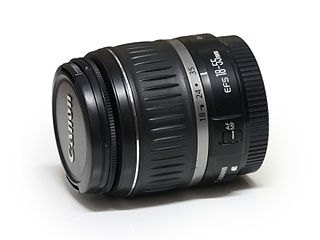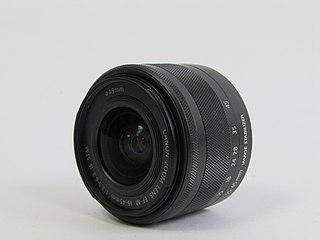
The EF lens mount is the standard lens mount on the Canon EOS family of SLR film and digital cameras. EF stands for "Electro-Focus": automatic focusing on EF lenses is handled by a dedicated electric motor built into the lens. Mechanically, it is a bayonet-style mount, and all communication between camera and lens takes place through electrical contacts; there are no mechanical levers or plungers. The mount was first introduced in 1987.

The Canon EF-S 18–55mm lens f/3.5–5.6 is a Canon-produced wide-angle to mid telephoto zoom lens for digital single-lens reflex cameras with an EF-S lens mount. The field of view has a 35 mm equivalent focal length of 28.8–88mm, and it is a standard kit lens on Canon's consumer APS-C DSLRs. In February 2017 Canon announced the new Canon EF-S 18–55mm lens f/4–5.6 IS STM with a smaller aperture, which made the lens 20% smaller according to Canon.

The EF 16–35 mm lens is a family of professional wide-angle lenses made by Canon Inc. The original version, the EF 16-35mm f/2.8L USM, replaced the EF 17-35mm f/2.8L USM lens, which had itself replaced the EF 20-35mm f/2.8L lens.
A kit lens is a "starter" lens which can be sold with an interchangeable-lens camera such as a mirrorless camera or DSLR. It is generally an inexpensive lens priced at the lowest end of the manufacturer's range so as to not add much to a camera kit's price. The kit consists of the camera body, the lens, and various accessories usually necessary to get started. A kit lens can be sold by itself outside of a kit, particularly the ones that are moderately expensive; for instance a kit lens included in a prosumer camera kit is often marketed as an upgrade lens for a consumer camera. In addition, retailers often have promotions of standalone low-end camera bodies without the lens, or a package that bundles a body with one or two more expensive lenses.
The EF 80–200mm lens is a discontinued telephoto zoom lens made by Canon. The lens has an EF lens mount that fits the EOS line of cameras.
The Canon EF 28–105 mm f/4–5.6 is an inexpensive zoom lens often included as a kit lens with Canon 35 mm single-lens reflex cameras. 28–105 mm is a standard wide to telephoto zoom range. The Canon EF 28–105 mm f/3.5–4.5 USM is a higher quality zoom lens with a better build quality. Currently every version of this lens is discontinued. Some versions of the lens may include the word macro or a flower icon which indicates macro capability, however due to the 1:5.2 image magnification ratio it cannot be considered as a true macro lens.
The EF 70–210mm lens is a discontinued telephoto zoom lens made by Canon Inc. It came in two different versions.
The EF 24–105mm f/4L IS USM is an EF mount wide-to-telephoto zoom lens. It was introduced by Canon in 2005 to complement the well-regarded 17–40mm f/4L USM and 70–200mm f/4L USM.
The EF 100–400 mm f/4.5–5.6L IS USM is a professional EF mount telephoto zoom lens manufactured by Canon Inc. The first version of this lens was announced in September 1998, and an updated version was announced in November 2014. It is a high performance telephoto lens most often used for sports and wildlife photography.

The Canon EF-S 17–55mm f/2.8 IS USM is a standard zoom lens for Canon digital single-lens reflex cameras with an EF-S lens mount. The field of view has a 35 mm equivalent focal length of 27–88mm.

The Canon EF 400mm are seven super-telephoto lenses made by Canon. These lenses have an EF mount that work with the EOS line of cameras. These lenses are widely used by sports and wildlife photographers.
The EF 70–300mm lenses are a series of telephoto zoom lenses made by Canon Inc. They have a Canon EF lens mount to work with the EOS line of cameras.

Introduced in 1991, the Canon EF 75–300mm f/4–5.6 lens is a telephoto zoom lens for Canon EOS single-lens reflex cameras with an EF lens mount. There are 3 basic types of the lens: the IS USM, the USM and non-USM. All 3 types are generally considered to be low-end consumer-level lenses.
The Canon EF 90–300mm f/4.5–5.6 lens is a telephoto zoom lens for Canon EOS single-lens reflex cameras with an EF lens mount. There have been two versions available: one with and one without USM.

The EF 100–300mm refers to three telephoto zoom lenses produced by Canon. They are of the EF lens mount that is compatible with the EOS line of cameras.
The Canon EF-S 18–135mm lens is a standard to short telephoto telezoom for Canon digital single-lens reflex cameras with an EF-S lens mount. The field of view has a 35 mm equivalent focal length of 29–216mm. With its 7.5× zoom range, it is placed into the superzoom category. Canon offers further lenses with even higher zoom ranges, such as the EF-S 18–200mm lens.

Canon EOS M is the first mirrorless interchangeable-lens camera produced by Canon.

The Canon EF-S 10–18mm f/4.5–5.6 IS STM lens is a wide to ultra-wide angle zoom lens for Canon digital single-lens reflex cameras that support the Canon EF-S lens mount. It was announced on May 13, 2014. though it began shipping to retailers by the end of May. It was Canon's 2nd ultra-wide lens with image stabilization to ship to retailers, the first being the EF-M 11–22mm STM. Canon announced a 16–35mm lens with IS on the same day as the 10–18.

The Canon EF-M 15-45mm f/3.5-6.3 IS STM is an interchangeable zoom lens, covering fields of view from wide-angle to short telephoto, for the Canon EF-M system of Canon Inc. mirrorless interchangeable-lens camera. It was announced by Canon on October 13, 2015, together with the new Canon EOS M10 camera. The lens uses STM technology and a collapsible design which takes up less space when the lens is not in use.

The Canon RF lens mount is an interchangeable-lens mount developed by Canon for its full-frame mirrorless interchangeable-lens cameras, and featured first by the EOS R, followed by the EOS RP. The RF mount was announced in September 2018. In May 2022, Canon announced APS-C EOS R cameras and RF-S lenses designed for these cameras.













